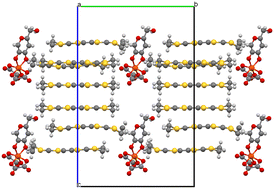Introduction of new guest molecules into BEDT-TTF radical-cation salts with tris(oxalato)ferrate†
Abstract
Radical-cation salts of formula β′′-(BEDT-TTF)4[(H3O)Fe(C2O4)3]·guest have produced a large number of superconductors and provided a route to introduce magnetism and chirality into the same multifunctional material. A relationship has been found in these salts between the length of the b axis and the superconducting Tc. Increasing the b axis length by introducing larger guest molecules, such as benzonitrile and nitrobenzene, gives the highest superconducting Tcs in this family of salts. Smaller guests such as pyridine show no superconducting transition, whilst asymmetrical guests which are larger than nitrobenzene have given a different bilayered structure. Other potential guest molecules have been limited by their ability to be used as the solvent in which the crystals are grown via electrocrystallisation. This paper reports a method which introduces guest molecules into the crystal which are a solid or liquid additive within the crystal-growing solvent 1,2,4-trichlorobenzene:ethanol. We present the crystal structures of five new BEDT-TTF radical-cation salts with tris(oxalato)ferrate anions using guest molecules toluene, phenol, benzaldehyde, 4-bromobenzaldehyde, and kojic acid.



 Please wait while we load your content...
Please wait while we load your content...